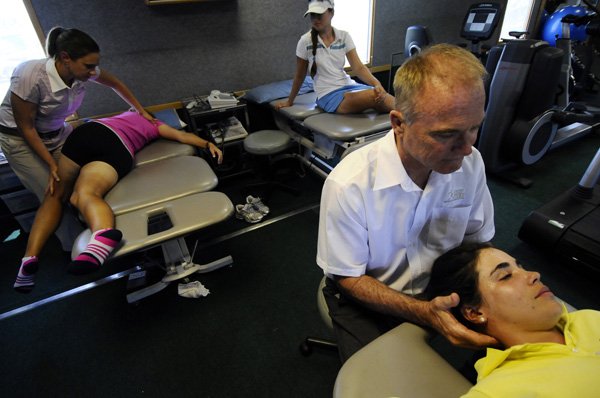ROGERS — From blisters to dislocated joints, golfers turn for help to the LPGA Sports Medicine Center that travels everywhere the pros go.
Caroline Nichols, head physical therapist for the LPGA, is in her third year as director, and has been with the program six years.
“We’ll probably see about half the field in a given week,” Nichols said Thursday at Pinnacle County Club. “Sometimes it’s higher than that. We see them for everything from a workout to a blister injury to where they can’t turn their head.”
Nichols and her staff have spent the week taking care of players preparing for the Walmart NW Arkansas Championship presented by P&G. Pro-am rounds finished Thursday and tournament play begins this morning.
Fast Facts
Tips For Amateur Golfers To Prevent Injury
• Warm up with a brisk walk or a set of jumping jacks. Stretch hands, wrists, forearms, elbows, shoulders, spine and pelvis. Swing a golf club a few times, gradually increasing range of motion.
• Start slowly. If a body isn’t conditioned for the strain, practicing a golf swing may do more harm than good. Work up to the desired level of activity instead.
• Strengthen muscles. The stronger muscles are, the greater a player’s club speed. Stronger muscles are less prone to golf injuries. For best results, do strength training exercises year round.
• Focus on flexibility. Regular stretching can improve range of motion and lead to a more fluid golf swing.
• Develop endurance. Regular aerobic activity can improve staying power on the course. Try walking, jogging, bicycling or swimming.
•Lift clubs carefully. Keep back straight and use the strength in legs to lift clubs and other heavy objects.
• Choose proper footwear. Dress for comfort and protection from the elements. Wear golf shoes with short cleats. Long cleats dig into the sod and hold feet planted as the club is swung, which may strain knees or ankles.
Source: Mayo Clinic
Players have arrived throughout the week while getting acclimated to the heat in Northwest Arkansas — although the tour’s last stop was in Ontario, Canada, where temperatures also hovered near 100 degrees.
“Typically, we don’t see too many heat-related problems,” Nichols said. “The players have been around long enough that they know how to hydrate and take care of themselves. It’s mainly the spectators that have the heat problems.”
Nichols said her group handles “a little bit of everything.”
“But primarily injuries,” Nichols said. “We handle sickness, workout programs, everything like that. But mostly, we work on the lower back, neck and shoulders. Wrists are big, too, depending on the course. If the ground is hard, we see a lot of wrist injuries, but mostly, it’s the back.”
And sometimes, Nichols added, the injuries aren’t necessarily golfrelated.
“We saw a dislocated shoulder at a tournament in Alabama,” Nichols said. “She’d fallen down some stairs. You just never know what’s going to walk through that door.”
But whatever comes through the door, with 144 players on tour, the medical staff is kept hopping, Nichols said
“People don’t understand that we’re busy all day long,” Nichols said. “The girls are swinging the club hundreds of times per day and playing rounds almost every day. We treat a lot of nagging injuries — ones that just won’t go away. People don’t see the injuries because no one is sliding into base like in baseball or making big hits like in football.”
Nichols said the medical team will also pick up local doctors at their tournaments — the Northwest Arkansas stop has a doctor from Fayetteville and another from Little Rock.
Dr. Kent Covert, who has a family practice in Little Rock, said he began working with the tour four years ago.
“I see a lot of rashes and a lot of allergies,” Covert said. “The allergens are diff erent in Arkansas, with the players coming from all over the world. There are also muscle strains and sinus problems.”
Allergens were in the low category Thursday, a 4 on a scale to 12, according to The Weather Channel, and were predicted to stay in the low to moderate range through the weekend.
“A couple of years ago, they came here from Canada, where there were no allergies, then they show up here,” Covert said. “That was when the tournament was in September and they had a lot of problems with allergies. It’s a little bit hotter this year, but in June, the allergies aren’t so bad.”
Nichols said her medical group handles all the LPGA stops in North America. The tour has another medical group under contract for Asian stops, Nichols said.
“The players are great,” Nichols said. “We’ve been here for years. We’re kind of like a family, where everyone has a function and we all just move from place to place.”

